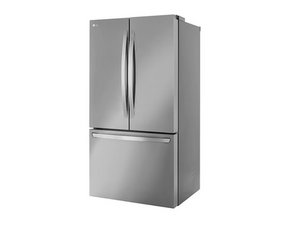The Basics
Your fridge should have :
- Power (the interior lights come on)
- An operating display (temperature indicators)
- Controls that respond. Keep in mind that a dead compressor may also give you an error code on the display.
- The condenser fan should run (the fan is located in the machinery compartment on the rear of the refrigerator.)
- The evaporator fan (inside the fridge usually in the freezer) should also run, although many are designed to shut off when the freezer door is opened.
- Listen for its operation with the door closed, or
- try and fool the unit into thinking the door is shut with tape on the door switch or a magnet near where the hinges are located.
If everything is in order on this list and you don't hear the compressor, let's look at what you can check.
Causes
One possible issue may be the electrical connections in the refrigerator have become loose or oxidized.
- Disconnect the power to your fridge.
- Disconnect and reconnect all of the connectors on the main control board. This guide will show you the location of the control board and also show you how to disconnect the connectors.
- Disconnect and reconnect the connector for the compressor. This guide shows how to do this for a linear compressor (the most common). Note that a linear compressor only has two terminals that actually connect to the compressor. The third prong makes no connection.
Test the fridge. If the compressor starts up, check to see that the interior of the fridge and freezer are cooling down. If not, go to the next item.

- 40 - 45 minutesModerate

- 30 - 35 minutesModerate
When you checked the electrical connections, you may have gotten a look at the thermal overload device for your compressor. If this has tripped or failed, the compressor is disconnected. It will not run.
- Follow this guide to test it and the compressor windings in one go.

- 30 - 35 minutesModerate
LG refrigerators, even with linear compressors, use a capacitor to help the compressor run properly (That's why it is called a run capacitor). You should test this capacitor. If it has failed, the compressor won't run or will run poorly.
- Make sure the power to the refrigerator is disconnected.
- Use this guide to access the capacitor. The size will be 10, 18, or 20 microfarads (µF).
- You can use a multimeter to test the capacitor. Some meters will have a capacitance function, and you will be able to read the value directly. In other cases, you can check the capacitor by using the resistance (Ohms, Ω) function. This only lets you know that the capacitor isn't shorted or open.
- Discharge the capacitor
- Connect the multimeter set to Ω to the capacitor, and you should see a low resistance, which rapidly increases. If you can, get a meter with the capacitance function and test the capacitor to check the actual reading.
- If things look good, go to the next item.

- 7 - 10 minutesModerate

- 5 minutesEasy
The one you have been dreading. You may already have tested the windings of your compressor by following the guide in the Compressor Thermal Overload section.
There are a number of mechanical failures that the LG Linear compressor is known for, and since it is sealed, if the windings test good, and the capacitor is good, you don't have much left to check. The main control board can provide some insight in this case.
There is a blink code on an LED located on the main control board that will allow you to have insight into some compressor problems.
- One Blink -- Compressor current and voltage error
- Two Blinks -- Stroke trip; Piston Stroke Overrun Detected
- Five Blinks -- Locked Piston Trip; the compressor piston is locked
- Six blinks -- High Current failure.
If these codes come up, you should have a professional evaluate the compressor, as replacement is beyond DIY capabilities and necessary qualifications.

- 30 - 35 minutesModerate
Your compressor may not run because the control board is bad. This could be the inverter portion of the board or other areas. You can test the output voltage of the board for the compressor. The control board has test modes that you can enter that will allow you to see if it is functioning correctly.
- The main failure will likely be that the inverter is unable to ramp up the voltage to the compressor within the specified timeframe.
- If the inverter doesn't achieve 200 volts output within two minutes, the control board is bad.
- There is a test button on the control board that allows you to enter diagnostic mode.
- The first push will cause the display to show 88 88 on the two temperature displays accompanied by one beep.
- The second push shows 22 22 and beeps twice.
- The third shows 33 33 and beeps three times. If the board will not respond in this way it is likely bad and should be replaced.
- Each of those test modes also allows you to evaluate the function of various subsystems.
If the control board doesn't respond properly, replace it.
You're seeing solutions for LG Refrigerator. Select your model to find parts for your device.







